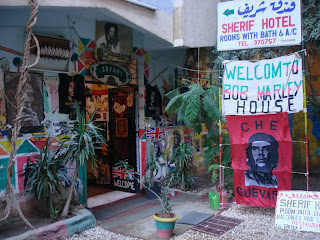The next morning, we got up early to head over to one of the crown jewels of Egypt, the Temples of Karnak. First, I think it appropriate to tell you about the hostel we stayed in. Marja, one of my friends on this trip, thought it might be fun to stay here when she booked our rooms. As you can see, the Bob Marley House seems to cater to a certain kind of traveler. In spite of the decor on the outside, the rooms inside were very nice, and the service was great. Still, it was quite the surprise when we first checked in.

The Bob Marley House, our hostel in Luxor
I think my LonelyPlanet guide put it pretty well when introducing the Temples of Karnak: "More than a temple, Karnak is an extraordinary complex of sanctuaries, kiosks, pylons and obelisks dedicated to the Theban gods and the greater glory of pharaohs. Everything is on a gigantic scale: the site covers over 2 sq km, large enough to contain about 10 cathedrals, while its main structure, the Temple of Amun, is the largest religious building ever built. This was where the god lived on earth, surrounded by the houses of his wife Mut, and their son Khonsu, two other huge temple complexes on this site. Built, added to, dismantled, restored, enlarged and decorated over nearly 1500 years, Karnak was the most important place of worship in Egypt during the New Kingdom."
So with that in mind, let's go in!

The walkway leading into the entrance
Walking towards the entrance to the temple complex, you pass an avenue of ram-headed sphinxes. After passing the first pylon (basically huge walls) marking the entrance of the complex proper, you head into the Great Court. The Great Court is flanked by huge columns on both sides, in addition to more pharonic statues, such as the one pictured below.

Statue of Ramses II
Passing under the watchful eye of Ramses II, you enter the Great Hypostyle Hall, which is a truly amazing hall filled with 134 columns covering over 5500 sq meters. The papyrus shaped pillars are supposed to symbolize a papyrus swamp.

Papyrus shaped pillars in the Great Hypostyle Hall
Leaving the Great Hypostyle Hall, you're eyes become fixed on the obelisks of Hatshepsut. One of the them is the tallest obelisk in Egypt, standing 30m high. After her death, her son, Tuthmosis III sought to destroy all signs of his mother's reign.

Obelisks of Hatshepsut
Passing by the obelisks, you notice tons of reliefs carved into the stones of the obelisks and the surrounding walls. Continuing onwards, you reach the Middle Kingdom Court, where the Wall of Records is located. The Wall of Records depicts reliefs recounting the amount of tribute exacted by the pharaoh in honor of Amun. Beyond the court, you reach the Great Festival Hall of Tuthmosis III, which is a unique structure because of its tent pole like stone columns (these may refer to the pharaoh's life while on campaign because he would have slept in a tent). Further on, you enter the Botanical Gardens (sorry, no more flowers) that has reliefs of the flora and fauna from Syria and Palestine. Finally, at the end of the complex, you reach the largely destroyed Sanctuary of Amun-Ra. On our way back to the front of Karnak, we passed by the Sacred Lake (if you can call waste water sacred?). Still, I thought it'd be nice to get a shot with the Temple in the background.

At Karnak, next to the Sacred Lake
Karnak's sheer size would amaze anyone, and I wasn't an exception to the rule. I couldn't imagine what it must have been like during its hey-day, when thousands of worshipers would visit to bring offerings, pray, or even to just visit. This was one of the many instances that I wish I could have gone back in time to see and experience what Karnak was.
Leaving Karnak, we took a cab over to the Luxor Temple; however, with money running short, we opted to view the Luxor Temple from the sides and walk around.

Luxor Temple
Luxor Temple was constructed by the pharaohs Amenhotep III and Ramses II (what hasn't he done?), and it lies in the center of modern day Luxor. At one point the Temple served as a Roman Fort, of which there are still ruins on the outside of the temple. Also, there is a mosque in one of the courts of the temple, and if I'm not mistaken, it was probably erected much later than the rest of the temple. Just going to throw that out there.
Having seen the two main attractions on the East Bank, we grabbed lunch then walked around a touristy suq (like Khan al-Khalili except really small) where we were pressured to buy things. I was able to resist the urge, or rather, the shop owners realized I had no money.
That evening, 2 of the girls in the group and I got on an earlier train so that we could get to class the next day. The train ride back was shorter than the first one. Unfortunately, we didn't get a sleeping car, and even though the seats were comfortable, the lights were on the entire time! Seriously, who needs the lights on at 3 am? Anyways, I got back to Cairo around 3 and within seconds of getting back to my dorm room, passed out on my bed.
Hope you enjoyed Upper Egypt! Next stop: the Sinai Peninsula.
Ma'a salaama,
Blair










































